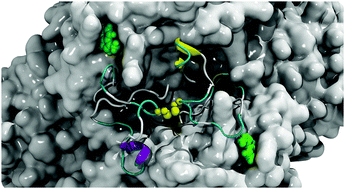当前位置:
X-MOL 学术
›
Mol. Biosyst.
›
论文详情
Our official English website, www.x-mol.net, welcomes your feedback! (Note: you will need to create a separate account there.)
Molecular dynamics simulations and in vitro analysis of the CRMP2 thiol switch
Molecular BioSystems Pub Date : 2017-06-27 00:00:00 , DOI: 10.1039/c7mb00160f Daniel Möller 1, 2, 3, 4, 5 , Manuela Gellert 3, 4, 5, 6, 7 , Walter Langel 1, 2, 3, 4, 5 , Christopher Horst Lillig 3, 4, 5, 6, 7
Molecular BioSystems Pub Date : 2017-06-27 00:00:00 , DOI: 10.1039/c7mb00160f Daniel Möller 1, 2, 3, 4, 5 , Manuela Gellert 3, 4, 5, 6, 7 , Walter Langel 1, 2, 3, 4, 5 , Christopher Horst Lillig 3, 4, 5, 6, 7
Affiliation

|
The collapsin response mediator protein CRMP2 (gene: DPYSL2) is crucial for neuronal development. The homotetrameric CRMP2 complex is regulated via two mechanisms: first by phosphorylation and second by the reduction and oxidation of the Cys504 residues of two adjacent subunits. Here, we have analysed the effects of this redox switch on the protein in vitro combined with force field molecular dynamics (MD). Earlier X-ray data reveal the structure of the rigid body of the molecule but lack the flexible C-terminus with the important sites for phosphorylation and redox regulation. An in silico model for this part was established by replica exchange simulations and homology modelling, which is consistent with the CD spectroscopy results of the recombinant protein. Thermofluor data indicated that the protein aggregates at bivalent ion concentrations below 200 mM. In simulations the protein surface was covered under these conditions by a large number of ions, which most likely prevent aggregation. A tryptophan residue (Trp295) in close proximity to the forming disulphide allowed the measurement of the structural relaxation of the rigid body upon reduction by fluorescence quenching. We were also able to determine the second-order rate constant of CRMP2 oxidation by H2O2. The simulated solvent accessible surface of the hydroxyl group of Ser518 significantly increased upon reduction of the disulphide bond. Our results give the first detailed insight into the profound structural changes of the tetrameric CRMP2 due to oxidation and indicate a tightly connected regulation by phosphorylation and redox modification.
中文翻译:

CRMP2硫醇开关的分子动力学模拟和体外分析
胶原蛋白反应介质蛋白CRMP2(基因:DPYSL2)对神经元发育至关重要。同四聚体CRMP2复合物通过两种机制调节:第一是通过磷酸化,第二是通过还原和氧化两个相邻亚基的Cys504残基。在这里,我们结合力场分子动力学(MD)分析了这种氧化还原开关对体外蛋白质的影响。早期的X射线数据揭示了分子刚体的结构,但缺乏具有重要的磷酸化和氧化还原调节位点的柔性C端。一个在硅片通过复制交换模拟和同源性建模建立了该部分的模型,这与重组蛋白的CD光谱结果一致。Thermofluor数据表明蛋白质在200 mM以下的二价离子浓度下聚集。在模拟中,在这些条件下,蛋白质表面被大量离子覆盖,这很可能会阻止聚集。紧靠形成的二硫化物的色氨酸残基(Trp295)允许通过荧光猝灭法测定刚体的结构弛豫。我们还能够确定H 2 O 2氧化CRMP2的二阶速率常数。当二硫键还原时,Ser518羟基的模拟溶剂可及表面显着增加。我们的结果对四聚体CRMP2因氧化而产生的深刻结构变化有了第一个详细的了解,并指出了通过磷酸化和氧化还原修饰产生的紧密联系的调节作用。
更新日期:2017-08-22
中文翻译:

CRMP2硫醇开关的分子动力学模拟和体外分析
胶原蛋白反应介质蛋白CRMP2(基因:DPYSL2)对神经元发育至关重要。同四聚体CRMP2复合物通过两种机制调节:第一是通过磷酸化,第二是通过还原和氧化两个相邻亚基的Cys504残基。在这里,我们结合力场分子动力学(MD)分析了这种氧化还原开关对体外蛋白质的影响。早期的X射线数据揭示了分子刚体的结构,但缺乏具有重要的磷酸化和氧化还原调节位点的柔性C端。一个在硅片通过复制交换模拟和同源性建模建立了该部分的模型,这与重组蛋白的CD光谱结果一致。Thermofluor数据表明蛋白质在200 mM以下的二价离子浓度下聚集。在模拟中,在这些条件下,蛋白质表面被大量离子覆盖,这很可能会阻止聚集。紧靠形成的二硫化物的色氨酸残基(Trp295)允许通过荧光猝灭法测定刚体的结构弛豫。我们还能够确定H 2 O 2氧化CRMP2的二阶速率常数。当二硫键还原时,Ser518羟基的模拟溶剂可及表面显着增加。我们的结果对四聚体CRMP2因氧化而产生的深刻结构变化有了第一个详细的了解,并指出了通过磷酸化和氧化还原修饰产生的紧密联系的调节作用。


























 京公网安备 11010802027423号
京公网安备 11010802027423号